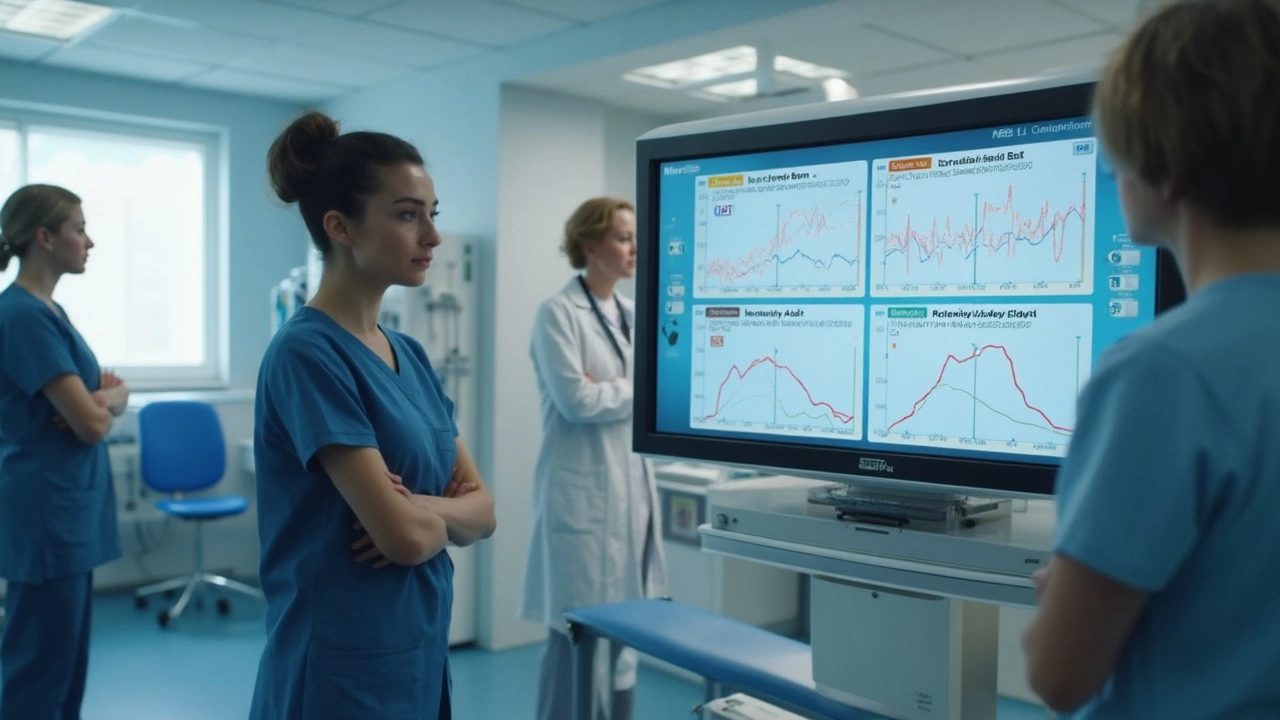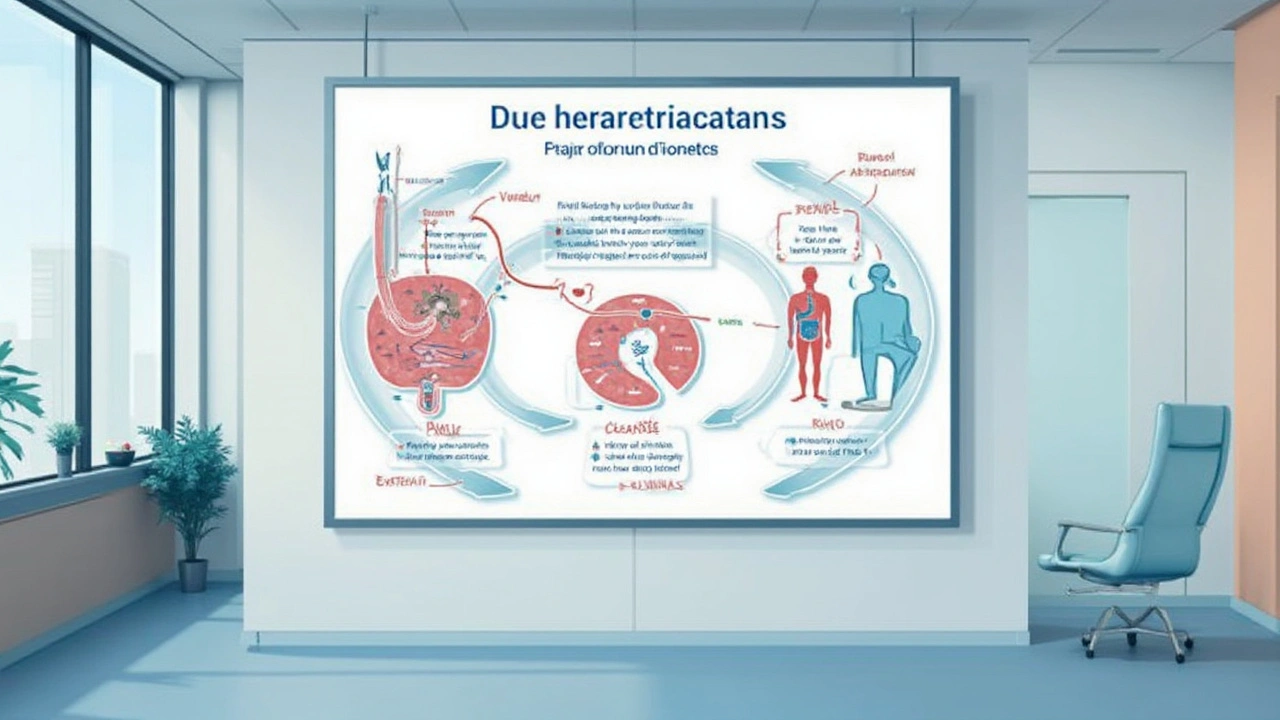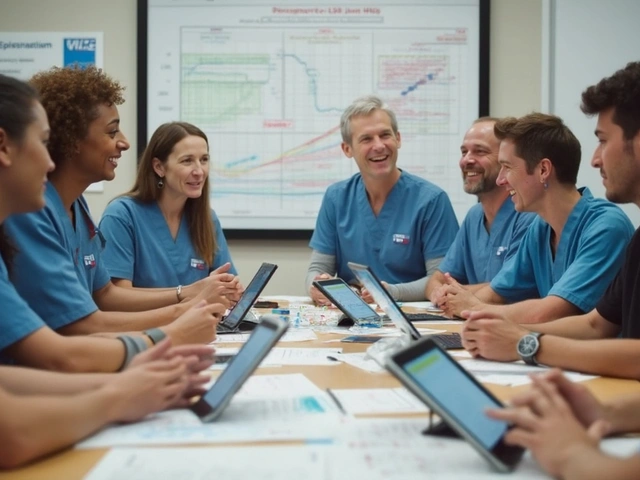Absorption: Rapid Uptake and What It Means for Dosing
Ask any neurologist about levetiracetam and the first thing you’ll hear is how quickly it kicks in—no slow build-up like the old-school drugs. Taken by mouth, levetiracetam has a bioavailability close to 100%, which basically means every bit you swallow gets into the bloodstream. It doesn’t mess around with the stomach much either. You can take it with food or on an empty stomach and the absorption is just as fast. Most people hit peak blood levels only 1.3 hours after a dose for the immediate-release form, while the extended-release pushes that to around four hours. One fun fact: this speedy absorption is why you can start someone on a regular dose without needing to “titrate up” and also why it’s so handy in emergencies when you want seizures stopped before things get out of hand.
The immediate-release tablets, liquids, and IV injectable forms all get to work fast. Extended-release versions stretch things out for better control in people who don’t want to dose twice a day. The absorption doesn’t depend on age or gender much, so whether you’re giving it to a teenager or a retiree, you can expect similar results. However, pregnancy does speed up the clearance, so monitoring levels matters a lot for expectant mothers dealing with epilepsy. If you’ve got a patient who threw up after dosing, don’t panic if it’s been more than 45 minutes—they probably absorbed a therapeutic chunk already. For those who think excipients and fillers in generics change things? No solid evidence has shown a real-world difference in clinical effect or blood level consistency between different brands.
Liquid levetiracetam makes things easier for kids and adults who can’t swallow pills, but the absorption doesn’t change. The drug doesn’t bind much to proteins in your blood, so it isn’t “knocked off” by other meds. When clinical situations demand IV dosing, expect a bioequivalent response to the oral version—researchers found almost identical plasma levels within an hour in hospital patients. This is a game-changer for switching between tablets and IV during acute admissions without complex math or conversion factors. So if you’re shuffling routes due to swallowing problems, you can relax knowing the numbers hold up. Really, the only hitch comes with certain types of enteral (feeding tube) nutrition; clogged tubes, delayed gastric emptying, and drug mixing errors can complicate things, so always check how the patient is taking their meds.
Let’s touch on something a bit quirky. Sometimes patients notice side effects like irritability right after dosing. It turns out, this isn’t always “dose-related toxicity” so much as the body’s quick jump to therapeutic levels. For those especially sensitive, splitting the daily dose into smaller chunks can take the edge off while keeping control stable. Rapid absorption pairs well with the drug’s lack of metabolism (covered next), but it does put more emphasis on getting the timing right for consistent blood levels. Missed doses mean effects fade quickly, so for patients with memory issues, using medication alarms or dose organizers can prevent unnecessary breakthroughs.

Metabolism and Pathways: Why This Matters for Drug Interactions
Here’s something that surprises a lot of clinicians: levetiracetam is barely metabolized by the liver. In fact, only about 24% of the drug gets broken down, and when it does, it’s mostly by a simple hydrolysis that doesn’t use the usual liver enzyme pathways, like CYP450. Why’s that so important? Those famous CYP pathways chew through tons of medications—think statins, warfarin, carbamazepine, and tons more—so drugs that use them are prone to endless risky interactions. Levetiracetam mostly dodges this pitfall. Patients on multiple medications, from antibiotics to antidepressants, can take levetiracetam without much fear of wild, unpredictable reactions or tweaking other drug levels.
This is huge for elderly patients, who often juggle a medicine cabinet’s worth of pills every day. One study in the journal Epilepsy Research found polypharmacy patients were less likely to have adverse drug interactions when levetiracetam was part of the regimen compared to older anticonvulsants. Even heavy metabolic stress, like in liver failure, doesn’t crank up levetiracetam levels to a dangerous place. Now, if you do a chromosomal breakdown of its tiny metabolite pool, you’ll see the main inactive product is ucb L057 (also called a carboxylic acid derivative). It doesn’t have any known clinical action and is just a biochemical curiosity.
One patient group worth a closer look: severe liver disease. While levetiracetam levels don’t usually budge with mild or moderate dysfunction, end-stage liver failure can result in slightly longer drug half-life. Still, the majority of clinicians don’t recommend dose changes except in extreme cases. So unless you’re following someone in a transplant unit, the usual approach stands. And since levetiracetam isn’t a significant enzyme inducer or inhibitor, starting or stopping it doesn’t mess up other antiepileptic levels. For patients who have trouble with tricky drug regimens, it offers a breath of fresh air.
If you’re thinking about routine lab monitoring, you won’t find much evidence that steady blood level checks are needed for most people. The drug’s lack of major metabolism or protein binding means levels don’t swing much due to weight changes, stress, or most intercurrent illnesses. Still, monitoring can help if a patient isn’t responding as expected, or if you suspect compliance issues. As one neurologist puts it:
“Levetiracetam’s simple metabolic pathway takes the guesswork out of managing complex polypharmacy patients—it just plays well with others.”You can find a deeper look at the mechanisms and clinical uses in this review of levetiracetam pharmacology that covers all the drug’s action points in practice.
Another thing to consider: some drugs can impact kidney excretion (next section), but there are zero confirmed reports of common substances (like grapefruit juice or green tea) meaningfully changing levetiracetam blood levels. It’s a contrast to classic anticonvulsants like phenytoin, where patients hear endless warnings about food, drink, or even sunlight exposure affecting metabolism. The “set it and forget it” attitude is honestly a relief for most families and caregivers.

Renal Clearance: The Key Factor in Dosing and Monitoring
This is where things get interesting. Levetiracetam is mainly cleared by the kidneys, with a whopping 66% to 70% of each dose expelled unchanged in the urine. That means kidney health isn’t just a footnote—it’s the main story when it comes to safe dosing. Healthy adults have an average half-life of about 6-8 hours, but if you plug the numbers into any pharmacy calculator, you’ll spot a pattern: as kidney function drops, blood levels of levetiracetam shoot up fast.
Let’s say someone has their glomerular filtration rate (GFR) cut in half due to chronic kidney disease (CKD). Suddenly, the drug’s half-life starts to stretch toward 15 hours. In severe kidney failure, levels can even double or triple before anyone realizes, putting someone at risk of confusing side effects like sleepiness or agitation. That’s why regular kidney function checks (usually with serum creatinine and estimated GFR) are a must, especially in patients over 65 or anyone with known renal disease history. Here’s a quick breakdown on what needs adjusting:
- GFR > 80 mL/min: Standard starting dose is fine.
- GFR 50–80 mL/min: Reduce the daily dose by 25%.
- GFR 30–50 mL/min: Reduce the dose by 50%.
- GFR < 30 mL/min: Reduce the dose by 75% or switch to less frequent dosing.
Dialysis changes the story. Up to half a patient’s levetiracetam dose can be washed out during a standard hemodialysis session. In those cases, standard advice is to give a supplemental dose after dialysis—usually about half the regular daily amount to keep seizure control smooth. Peritoneal dialysis, on the other hand, removes far less, so those patients stick closer to the CKD-based guidelines. A table for clarity:
| Renal Function (GFR) | Levetiracetam Dose Adjustment |
|---|---|
| >80 mL/min | No reduction |
| 50-80 mL/min | Reduce by 25% |
| 30-50 mL/min | Reduce by 50% |
| <30 mL/min | Reduce by 75% or increase dosing interval |
| Hemodialysis | Supplement with 50% of standard daily dose after session |
Pediatric patients, especially infants, clear levetiracetam faster on a weight basis than adults because their kidneys are more efficient relative to body size. However, premature babies or those with congenital kidney disorders may need even closer monitoring. For older adults living in care facilities, regular GFR checks—at least yearly—will spot declining clearance before issues arise. If you see confusion, hallucinations, or sudden mood changes in an older patient, don’t rush to blame dementia; a quick kidney function check can sometimes solve the puzzle, as inadvertent toxicity pops up more often than you’d guess.
This renal dependence is why hydration status also becomes important during acute illnesses; even a short bout of dehydration from a stomach bug can raise blood levels for a few days. You might hear patients ask: “Can I just skip a dose if I have kidney trouble?” Skipping doses isn’t the answer—adjusting and tracking levels with your prescriber is. And for family members giving levetiracetam through gastrostomy or nasogastric tubes, hormones or fluctuating fluid balance can sometimes alter absorption enough that checking drug levels makes sense when breakthrough seizures suddenly appear.
So what’s the practical tip? Build in kidney monitoring for every patient at risk—at diagnosis, whenever a major health change happens, and at least once a year for anyone over 60. Use dose organizers for folks on dialysis; mix-ups and missed doses are common but easy to solve with a little planning. And always keep communication lines open between neurology, nephrology, and pharmacy teams—shared decision-making keeps medication safe and seizures under control.




Michael Tribone
May 5, 2025 at 19:29This is such a refreshingly clear breakdown-seriously, why don’t more neuro posts explain meds like this? I’ve seen so many patients panic when they switch from phenytoin to levetiracetam, thinking it’s ‘weaker’ because it doesn’t make them drowsy right away. But nah, it’s just not trying to knock you out-it’s just doing its job. And the part about not needing to titrate up? Game changer for ER docs trying to stop status epilepticus without waiting 3 days for levels to climb.
Also, shoutout to the guy who mentioned vomiting after dosing-if it’s been over 45 mins, you’re probably fine. I’ve had nurses call me in a panic over that, and I just laugh and say ‘they’re not throwing up a whole pill, they’re throwing up the wrapper.’
Nancy Lowry
May 6, 2025 at 06:23Ugh. I can't believe people still think levetiracetam is 'safe' just because it doesn't use CYP enzymes. You're ignoring the renal clearance issue entirely. I had a 78-year-old woman on dialysis who got admitted with hallucinations and agitation-turns out she was on full dose because her nephrologist didn't know the adjustment rules. She ended up in the psych ward. No one's talking about how this drug's 'convenience' leads to deadly complacency. If you're not checking GFR every 3 months in anyone over 60, you're negligent. This post reads like a pharma ad.
Khanyisa Mhlongo
May 7, 2025 at 01:14OH MY GOSH, I JUST SCREAMED OUT LOUD WHEN I READ THE PART ABOUT DIALYSIS!!! 🙌🏽 I’ve been managing my brother’s epilepsy since he started on hemodialysis last year, and we were SO confused-why did he start having weird episodes right after his sessions? Turns out, they were washing out half his meds and not replacing it! I printed this out and gave it to his whole care team. Now they give him a half-dose right after dialysis, and he hasn’t had a seizure since. Thank you, thank you, THANK YOU for writing this like a human who’s actually been in the trenches. Also, the part about hydration? YES. He got dehydrated during a heatwave, and his levels spiked like a volcano. Now we keep a water bottle taped to his wheelchair. 🥹💧
Manvika Gupta
May 7, 2025 at 10:57this is so helpful!! i work in a clinic in delhi and we get so many patients who cant afford regular blood tests, so knowing that you dont need to monitor levels unless something’s off is a relief. also, the part about generics? yes!! so many patients here think the cheap ones dont work, but they do! just make sure they’re not expired or stored in the sun. and the kidney thing-so many old folks here have CKD and no one checks it. i’m gonna print this and put it up in the waiting room. thanks for making it simple 😊
Chloe McDonald
May 7, 2025 at 15:03Just wanted to say this is the most useful thing I’ve read all week.